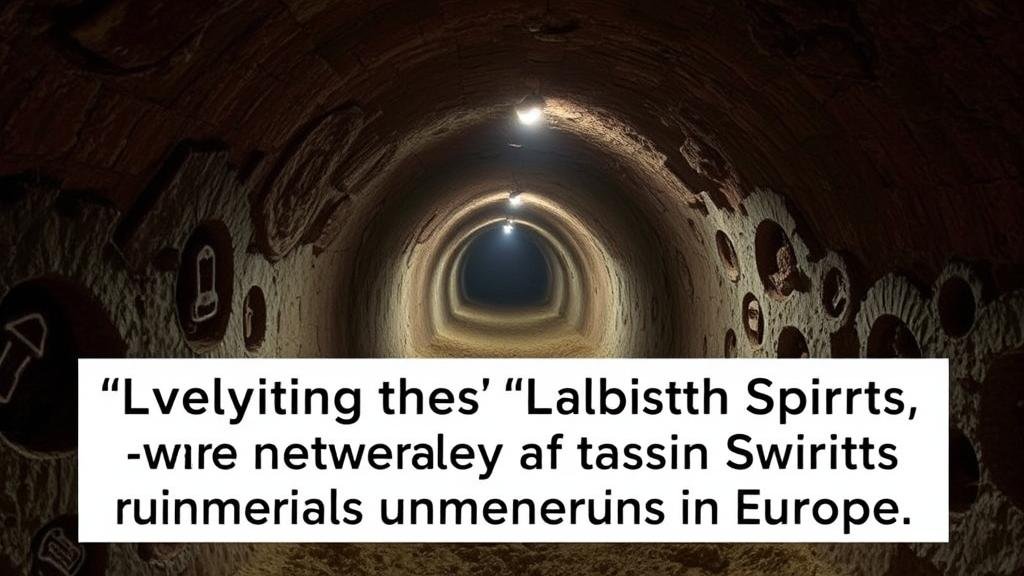Investigating the “Labyrinth of the Spirits,” a vast network of tunnels rumored beneath Europe.
Investigating the Labyrinth of the Spirits: A Journey into Europes Hidden Tunnels
Across the vast landscapes of Europe, whispers of a mysterious network of tunnels known as the Labyrinth of the Spirits have intrigued adventurers, historians, and urban explorers alike. These subterranean passages are rumored to date back centuries, intertwining with the histories of multiple cultures and cities. This article seeks to shed light on these enigmatic tunnels, their origins, and the ongoing investigations surrounding them.
The Origins of the Labyrinth
The Labyrinth of the Spirits is believed to have originated in the medieval period, with various cities across Europe claiming parts of this extensive network. For example, Paris is home to the Catacombs, which were established in the late 18th century to manage the city’s overflowing cemeteries. But, older tunnels beneath the citys surface hint at an even more complex history.
Another significant site is the underground passages of Edinburgh, Scotland, known as the Edinburgh Vaults. Built in the late 18th century, these were originally storage facilities, but as flooding and neglect took over, they became the subjects of haunting stories and ghostly encounters.
Geographical Spread: A European Tapestry
While the origins are often traced back to specific cities, the labyrinthine tunnels span across Europe, with notable sites including:
- Paris, France: Extensive catacombs that hold the remains of over six million people.
- Edinburgh, Scotland: Vaults under South Bridge, often described as haunted.
- Naples, Italy: The Napoli Sotterranea, a complex of tunnels with origins dating back to ancient Greece.
- Budapest, Hungary: A series of limestone caves that formed under volcanic activity and were later modified for various uses.
The Structural Features
The tunnels that make up the Labyrinth of the Spirits exhibit a variety of architectural styles and purposes ranging from drainage systems to catacombs. Most of these tunnels share common characteristics:
- Arched ceilings: Designed to support the weight of the earth above.
- Stone walls: Often hewn from the surrounding rock, giving evidence to hand-crafted labor.
- Ventilation shafts: Essential for keeping air circulation within the tunnels.
Modern Investigations
In recent years, modern technology has allowed researchers and enthusiasts to explore these hidden tunnels more effectively. Ground-penetrating radar (GPR) and 3D mapping techniques have revealed previously unknown sections of tunnels and helped document their condition. For example, in 2020, a collaborative effort between historians and tech experts in Paris uncovered a previously unseen segment of the Catacombs, adding to the known length of the citys underground maze.
Real-World Applications and Cultural Impact
The intrigue surrounding the Labyrinth of the Spirits goes beyond mere curiosity; it also serves as a means of preserving cultural heritage. e tunnels are invaluable to understanding the historical urban development of European cities. Plus, they play a crucial role in tourism, with thousands of visitors flocking to explore these historical sites every year.
Statistical data from the International Council of Museums states that historic tunnels contribute significantly to local economies, with sites like the Paris Catacombs attracting over 500,000 visitors annually, generating millions in revenue.
Addressing Concerns: Safety and Preservation
Venturing into these tunnels poses various risks, including structural instability and limited visibility. So, authorities in many cities have set strict guidelines to ensure safety for both explorers and tourists. For example, guided tours in the Catacombs of Paris are tightly regulated, limiting the number of visitors at one time to prevent overcrowding and potential accidents.
Conclusion: Embracing the Mystery
The Labyrinth of the Spirits remains a captivating enigma in Europe’s historical narrative. While mystery surrounds these tunnels, they also represent a rich tapestry of architectural ingenuity and cultural significance. For those eager to explore beneath the surface, whether through guided tours or academic studies, there is much to learn and appreciate about these hidden passageways that connect past and present.
As interest in these underground networks grows, it is crucial to balance exploration with preservation efforts, ensuring that future generations can also uncover the secrets that lie beneath our feet. For now, the labyrinth not only invites the curious but also challenges them to understand the complexities of history hidden in darkness.



